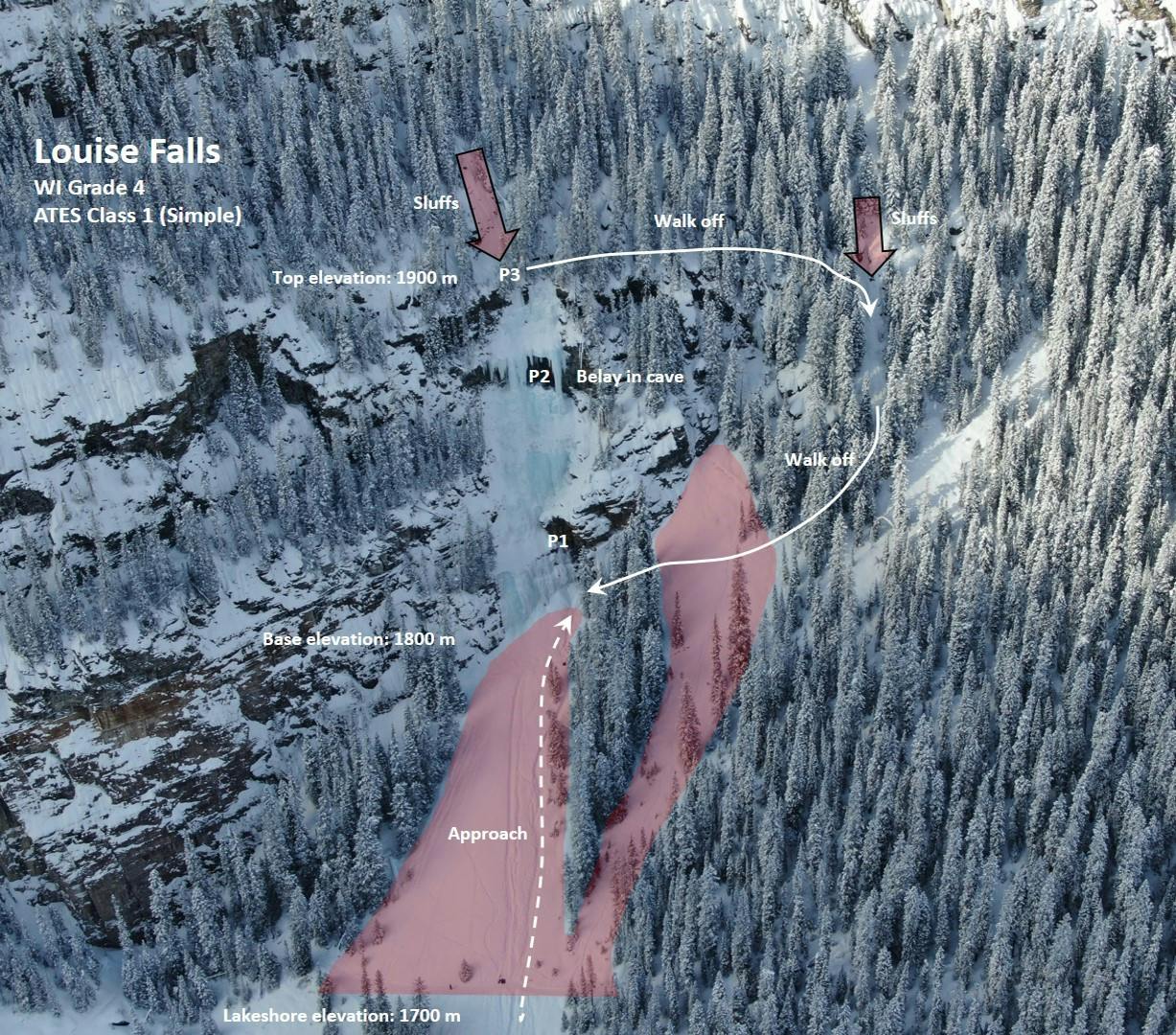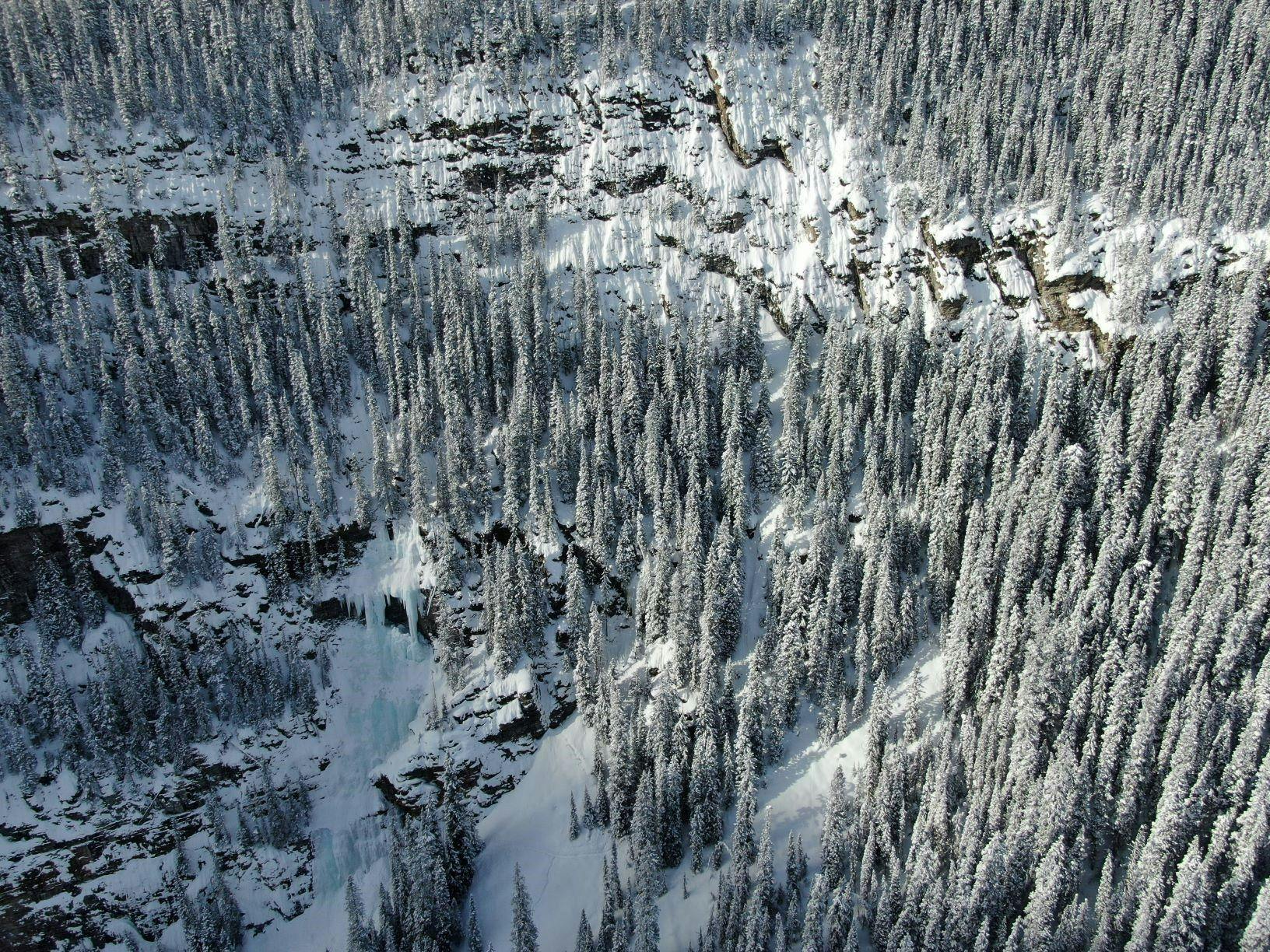WI 4, 120m
ATES 1 (simple)
A 40-minute walk from around the shoreline of Lake Louise brings you to the base of this very popular Rockies classic. With natural tiers to break up pitches, a striking pillar, minimal avalanche hazard and incredible views, this might be the most popular ice climb for its grade in the Rockies. It is not uncommon to wait in line at the base or behind the pillars for a safe time to proceed. Most climbers walk off the route to eliminate hazards to those climbing below. The walk off has more areas of concern for avalanche hazard.

- Credit
- Grant Statham/Parks Canada
Popularity
- 75 people completed the survey
- 44% climbed Louise Falls 1–5 times
- 16% climbed it 6–10 times
- 40% climbed it over 10 times
Avalanche frequency
- 73% have seen debris on the climb or below it, or on the walk off
- 27% have not seen any debris
- 52% have witnessed avalanches in the area of Louise Falls
Time of year and day
- February–April saw the greatest number of ascents and debris, then December to January, and lastly October to November
- 60%, of avalanches witnessed occurred from 12–6 p.m.
- 50% occurred from 6 a.m. to 12 p.m.
Avalanche start zones:
- 54% of respondents believe the avalanche started right above the climb
- 16% believe it started well above the climb
- 16% were unsure where it started
- 14% were human triggered on the descent

Runout debris
- 44% of respondents saw debris at the base of the climb
- 27% have seen debris in between the pitches of climbing
- 13% saw debris above the last pitch
- 44% saw debris on the walk off
Notes on avalanche debris
- A long time ago, I saw a fracture line just below the route and debris to the lakeshore. It seemed like a natural size 2 (maybe 50 cm deep?), probably triggered by loose avalanches from above the route.
- A few respondents noted debris that ran down the approach slope and almost to the ski track.
- Point releases can be triggered that funnel into the walk off. I have observed a few crowns in this pocket. The biggest slide in this area has been from the walk off. I would call it a size 1.5, but it was deep due to terrain.
- Size 1 on the approach, and on the descent.
- Many people have seen debris on the top out on climbers left, sometimes burying the belaying area.
- Many noted debris on low angle sections on the route, between the cave pitch and second pitch, and after the pillar pitch.
- Many have witnessed debris of various sorts at the base of the route.
- Debris has been seen covering the walk off tracks often, and running down the steeper section of the walk off.
Reported avalanches and incidents:
- Size 1 from top of climb in February 2012. Snowing for an hour prior to starting climb. The lead climber was on the steeps before the cave when the avalanche went over top, burying the belayer to high knee/waist level. Belay was in a poor location at bench climber’s right (poor/inexperienced belay location by me). When we topped out, there was a slab (20m x 15 m) that slid with 2.5m crown near the rock outcropping upslope, looker’s left of the top-out bolt station
- I was belaying the leader from the base when sluff from above blinded me with a snow cloud. Next thing you know, I was buried to just above the knees.
- Avalanches viewed across the lake that ran across the lake and dusted the sleigh turn around spot, reported eight times.
- We found a Layer of slush and snow on the entire climb. While belaying the leader at the base, I was buried to just above the knees
- Several people (10+) commented on experiencing sluffs and small avalanches while climbing the upper two tiers. The snow was enough to feel like it could easily knock a climber off. The start zone was from the left-side top-out and ranged from loose dry to heavier snow with tree branches in it.
- Several people mentioned having small slide occurrences on the walk off. No big incidents though.
- In spring, a natural slab released on the slope you traverse across (skiers right) at bottom of the descent to return to packs sometime while we were on the climb. It was very fresh when we got to it.
- Saw a sizeable slide come over the route with climbers on the pillar. It shot out over their heads, but it was pretty impressive.
Contributing factors:
- 88%: new snow amounts
- 40%: Warming and solar radiation
- 24%: Winds
- 10%: Cornice or human/animal trigger
- 7%: Known reactive layer
Descent
- 97% said they have used the walk off
- 26% said they have rappelled the route.
Summary:
- Louise Falls is in Class 1 (simple) ATES terrain, with limited un-treed terrain above it. It is a common place to climb when avalanche hazard is higher on other climbs with more serious terrain above them. However, the slope directly above the final pitch, along with snow mushrooms and tree bombs, have resulted in numerous near misses for climbers on the last pitch and the pillar pitch. Enough snow can sluff off these features to knock a leader off their feet and it is something to be aware of in times of recent new snow or sun hitting the top out.
- Most people walk off Louise falls due to the high level of traffic on the route that would be further complicated by rappellers. The walk off is more exposed to patches of avalanche terrain and many people consider wearing avalanche gear for this reason. A slide at the wrong time could send an unroped climber on a dangerous fall and potential burial.
- Louise Falls has the additional hazard of huge daggers and pillars that can spontaneously combust during temperature changes and completely threaten the entire lower half of the climb.
- Busy days on Louise Falls require a great deal of coordination and communication among parties to keep everyone safe from ice fall.
- Temperatures can vary drastically on the route within the same day, with often cold overnight temps that warm up as the sun hits the route. This can change the ice and the snow quite significantly in a short period of time.
- The approach slope to Louise Falls can produce slab avalanches, but this is very rare these days due to constant compaction on this slope from hikers, climbers and icefall.